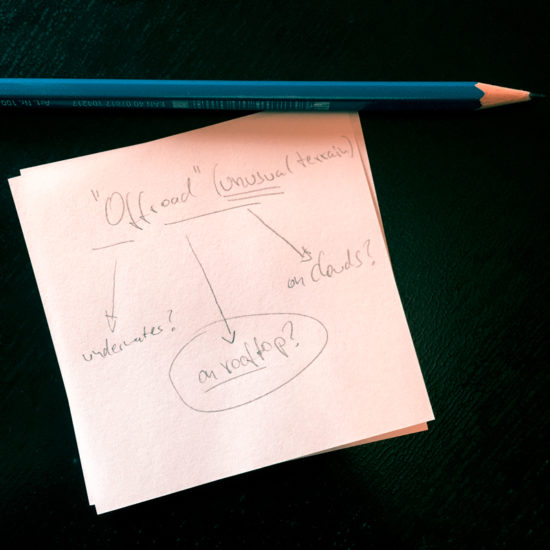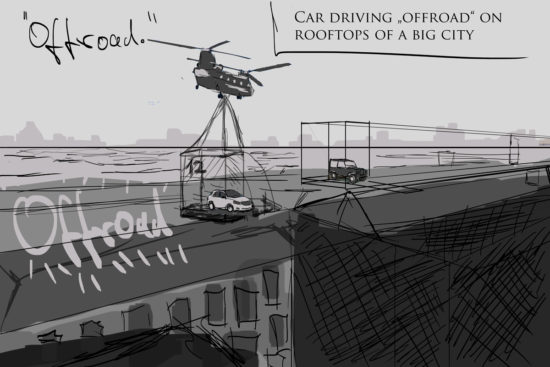I like working conceptual.
That means most things I work on, have a concept behind them on which I worked beforehand – sometimes hours, sometimes days. “Why?”, you might ask – well, for me every artwork, portrait or composing starts with a question like – “How do we reach more people?”, “How do we portrait the artist that the looks fits the concept of his new album?” or similar questions and from there on we work our way forwards. This not only gives me more opportunities to work with but also offers a great variety to cliens and this results in a very specific work in the end. It’s all about brainstorming, gathering ideas and pick the best – or sometimes also the most affordable. So let’s get down to some example:
When I narrowed down all the questions that arose to one key question, it might look like this:
“What sort of image can make some vehicle for “offroad” driving seem more interesting than putting it in some sort of forest or desert?”
So I thought of different scenarios like having a car driving underwater on a reef, an urban rooftop or even on clouds in the sky. To be honest, the underwater idea was there for quite some time but as I haven’t had some sort of reef nearby when I was living in Berlin – I went for the idea I thought would be pretty amazing but also some sort of funny; to have a car drive on a rooftop and simply call it “Offroad”. There are quite some amazing photographers out there that build a concept around their pictures before they start flat out shooting different things and think about an idea afterwards (although that does NOT have to be bad – it’s just a different approach that comes to amazing results as well) – see for example Erik Johansson – he’s an amazing photographer who shows that using a strong concept for his work pays off and is often his very own way to achieve such amazing, reality-bending, pictures over and over again. But first back to my concept-thoughts:

From there on for me it’s doing sketches, scribbles and have a look what would work in my opinion. Brainstorm, sketch it out, start over again. Until I am satisfied with it and can start thinking about locations to work in and the things I need to keep track of (lighting of background and subject). My first idea was a helicopter delivering the car – but then I after I sketched it out, I thought to myself it makes it look even better and makes more sense if the “offroad”-car already got there itself (because when it’s “truly offroad” it can get there by itself, right?;-)). So I thought about some sort of parking lot/space on top there and sketched it out.

The Rooftop-scenery was found pretty quick, as Berlin has a lot of cityscapes that don’t look too futuristic and have a nice texture – we went for a nice little neighbourhood somewhere in the east, without big skyscrapers and everything. Afterwards we had the picture with the car in front of a sort-a neutral background and from a decent angle – and a sky that could make it look like it’s been cloudy and rainy all day. I tend to shoot my backgrounds always first – although I’m sure it’s possible to do it the other way ’round (for example Matthias Schwaighofer – or for someone who’s planning and preproducing an immense time before he shoots, watch Benjamin von Wong‘s works – e.g. his Mermaid shoot just blew me away!) For me it’s just easier to already have a background and then imagine the subject in it before I shoot again – just my preferred way of working.
From then on it’s postproduction all the way.
I wanted some sort of “parking lot on the rooftop” for the car to come out of… I tried several set-ups, with a wooden-box, some sort of concrete walls. But since the car should be thing to watch out for – although it’s not the biggest part in the image – I went for glass.
[twenty20 img1=”2274″ img2=”2275″ width=”800px” offset=”0.5″]
To exaggerate the concept a bit I put up the big neon-Offroad sign on the rooftop in front and turned the whole scene into night and created a rainy atmosphere to enhance the mood of being offroad even further. The water droplets and lens flares have all been photographed separately in studio and took quite some time as well – but as I always want a perfect image in the end, this was necessary and it was worth it (see down below in the making of).
All in all this took quite a lot of hours to work on and in the end had more than 350 visible layers. That’s what a conceptual work looks like when there’s no client in the back and I can work freely on everything – for clients work the process looks a little different because there are a lot of more people involved in the process 😉
So here’s a layer breakdown of my piece “Offroad” – in the final version it’s been 353 active layers in Photoshop; quite some, huh? By the way – Josh Rossi also did an amazing job working for about 300 hours (!) on ONE single image, it’s amazing, have a look!
So my all-time favorites on composite photography are Erik Almas (he’s amazing on commercial work), Erik Johansson (in my opinion one of the most impressive artists out there, if you like surreal stuff in the slightest way – have a look as his artworks!) and Andric Ljubodrag
Which are yours? I’m eager to read some new names, because I’m pretty sure even I don’t know everyone out there, and I just LOVE to explore great portfolios!
PS: If you want to watch someone who’s really into preproduction – have a look at Benjamin von Wong – he does spend a LOT
And if you like this post, please make sure to put yourself in the newsletter-bar below,
yours, J